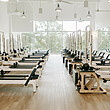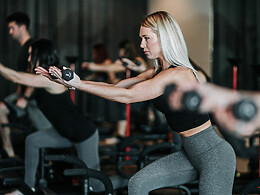By DuMaine Corbin
When you’re exercising on a regular basis, it’s important to assess what goals you are looking to achieve. Asking yourself a few questions can help you determine exactly what you are hoping to accomplish each day at the gym. Questions such as, what is your fitness goal? Are you looking to build enough strength to crush your PR (personal record), or do you want to burn fat and lean out? Whatever it is that you’re looking to achieve, adding explosive exercises to your workout will help to get you closer to reaching your goal.
What is Explosiveness?
Explosiveness (or explosive strength) is the ability to produce maximum force in minimal time. It is critical for quick movements such as sprinting, jumping, hopping, leaping, bounding, punching, throwing, kicking, cutting, juking, diving, the list goes on. Explosiveness is commonly used synonymously with power. While the two are related, power is actually what results from explosive strength. So if power is what you crave, then you’ll want to develop explosiveness.
Why do I need it?
- Fat loss. The biggest benefit to explosiveness is fat loss. For many people, fat loss is a common training goal. Adding new movements (namely explosive ones) fosters an increased metabolic demand due to inefficiency. Who knew being inefficient at something would be beneficial to your health? Win-win!
- Build muscle. Explosive movements increase muscle fiber recruitment. Simply put, the more muscle fiber you activate, the more fibers you can exhaust while training, increasing muscle size.
- More energy. It’s no secret that any exercise requiring both power and speed can quickly cause fatigue. Incorporating these types of exercises in your regimen will bring forth metabolic adaptations, giving you more energy between sets — and throughout everyday activities.
- Improve or maintain your athleticism. What separates great athletes from the rest isn’t strength, speed or even will power, but intramuscular coordination. Luckily, this is coordinated firing of motor units within a single movement is a skill that can be developed using explosive movements.
- Improve central nervous system function. By recruiting a larger number of motor units, explosive and reactive movements make the mind more alert and focused, so you can use these them to increase your alertness before you need to do something that’s explosive, fast or requires maximum attention. This, in turn, sharpens your reaction time allowing you to react faster to prevent tripping, falling and other accidents.
Take your fitness to the next level with these five explosive exercises:
- Depth Tuck Jumps
How to do it:
Phase 1. On a bench or medium box, stand with your feet between slightly wider than hip-width apart and soften your knees (bend slightly).
Phase 2. Bend your hips and knees to lower your body into a quarter squat with hips and knees bent, chest lined up with your toes, looking forward, and ready to explode. Your torso should be about 45 degrees to the floor with your lower back in its natural arch. Swing your arms back as you bend your hips back so that they run parallel to your spine. Think of it as compressing a spring as you dip your hips down and back before you explode upward.
Phase 3. Immediately rise up, extending your hips, knees, and ankles (come up onto your toes) and swinging your arms forward and up to jump as high as you can into the air. As you rise, pull your knees upward with you, tucking them under your chest. Your thighs should end up parallel to the floor. Keep your chest tall as you tuck.
Phase 4. Extend your knees on the way down, landing on the balls of your feet, bending your hips and knees as needed to absorb the force of the ground. You should end in the same athletic position in which you started the jump.
- Burpee to Star Jump
How to do it:
Phase 1. Begin standing in the universal athletic stance mentioned above.
Phase 2. Place your hands on the floor directly in front of, and just inside, your feet. Shift your weight onto your hands.
Phase 3. Jump your feet back to softly land on the balls of your feet in a plank position. Your body should form a straight line from your head to heels. Be careful not to let your back sag or your butt stick up in the air, as both can keep you from effectively working your core.
Phase 4. Jump back with your feet landing just outside of your hands.
Phase 5. With your arms leaving the ground first, jump explosively into the air and extend your arms and legs to create an “X” with your body.
Phase 6. Land and immediately lower back into a squat for your next rep. Repeat.
Modification: It should be noted that modifying this exercise would take away from its explosive benefit. Modify the burpee by walking feet up and back, one at a time (Phases 3 and 4), which limits the amount of jumping.
- Skater Lunge
How to do it:
Phase 1. Begin in the universal athletic stance, this time with your legs slightly wider than shoulder-width apart.
Phase 2. Bring one leg behind at a slight angle into a reverse lunge (the front knee should come to a 90-degree angle).
Phase 3. Swing the arms in front of that bent knee and leap the back leg forward to switch sides in a skating motion. alternate arms as you switch sides like a speed skater.
Modification: Leave out the lunge upon landing, instead bend knees just enough to absorb any shock. Another modification would be shortening the distance of the side to side jump
- Push Press
How to do it:
Phase 1. Stand with feet shoulder-width apart and grip the bar with your fingers and elbows pointing forward.
Phase 2. Rest the bar on the front of your shoulders.
Phase 3. Drop down into a shallow squat, centering your weight under the barbell.
Phase 4. Press up through your heels.
Phase 5. Drive the bar directly above your head until your arms are straight.
Phase 6. Lower the bar down to your chest.
- Plyo Push-ups
How to do it:
Phase 1. Begin down on all fours with your feet slightly narrower than hip-width, your body straight from your head to heels, and your hands in line with (but slightly wider than) your shoulders. Squeeze your glutes and brace your core to lock your body into position.
Phase 2. With your elbows tucked toward your ribcage, lower your torso until your chest is within a few inches of the floor, and then push up explosively with enough force for your hands to leave the ground.
Phase 3. Land softly to absorb the shock and transition immediately into your next rep.
Modified: After the push-up, land one hand at a time, one right after the other.
Be mindful while performing these movements. Although these movements are done rapidly, they are still very concise and each rep is to be done with purpose and proper form. Also, when it comes to loading up the resistance, less is more. With time you’ll want to add more but remember that force production is limited to the speed at which you can lift a load.










